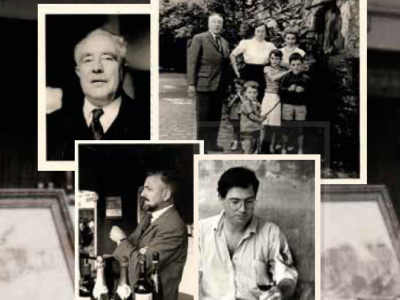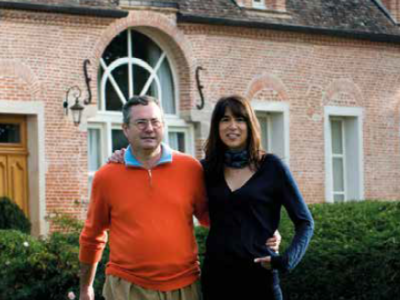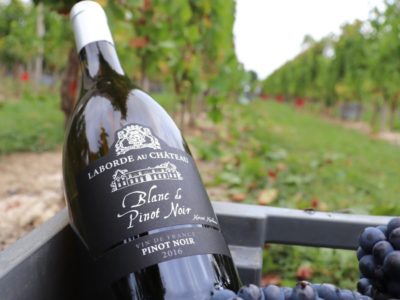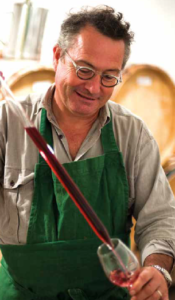Exclusive interview for « Le Vigneron » Magazine
A “wine trotter” from Britanny, raised in the Bordeaux region and who fell in love with Gevrey-Chambertin”. At first negociant, he took the plunge and is now on the other side.
Originating from Brittany, Hervé Kerlann belongs to these wine trotters whose path in life was not a straight line. The first decades are fast-paced: Africa, Denmark, London, Montreal and Vancouver, not to mention the childhood in Bordeaux: “My mother is of the Chèze family, allied by marriage to the Borie family, I am half-Corrèzian, thus cousin with some large Bordeaux wine families. “If the wine vocation awakens quai du Priourat in Libourne, in the family business, this curious and passionate perfectionist alos succeeds in everything he undertakes. It is in Canada where he markets the wines of the whole world that he appreciates the wines of Burgundy. In the early 1990s, he decided to settle in Côte-d’Or with his wife, a Canadian born in India.[/vc_column_text]


“When I arrived at the Château de Laborde, 10 kilometers from Beaune, the buildings were in poor condition, and we had to rebuilt stone by stone.” Distributing all the big stars of Côte-d’Or in Asia, Hervé also prides itself on winemaking while possessing a good vine-grower’s wisdom. He listens, observes and retains very quickly. At the same time merchant and owner, he loves challenges. The one started on Gevrey-Chambertin for the 2015 vintage is one of the most exciting: “I had been distributing wines from the Heresztyn estate for several years. When the two brothers, Stanislas and Bernard, retire, Bernard makes me a multi-year contract of all his grapes for his part of the estate which includes 2 hectares on Gevrey. “For three years, there has been a perfect understanding between the two men. The active retiree still oversees the cultivation of his vines placed in lutte raisonnée under the baton of Hervé Kerlann: “I almost turned to organic but the use of copper questions me, I will try the seaweed to better treat the soils, “explains the native of Brittany.


To obtain a complete phenolic maturity, keeping the grapes in vats at 13 ° C for five days seems necessary. With this temperature level, it is possible to stabilize the enzymatic phase without triggering fermentations by the yeasts. This brings complexity from the beginning of the fermentation. “I like a wine profile that is based on a natural acidity that keeps the wine alive. The tannins must be discreet and flexible, with the winemaker’s signature revealed by the finish. That’s why I do not punch the cap anymore as soon as the alcohol content of the must increases, otherwise it might extract hard, bitter aromas.
To obtain a complete phenolic maturity, keeping the grapes in vats at 13 ° C for five days seems necessary. With this temperature level, it is possible to stabilize the enzymatic phase without triggering fermentations by the yeasts. This brings complexity from the beginning of the fermentation. “I like a wine profile that is based on a natural acidity that keeps the wine alive. The tannins must be discreet and flexible, with the winemaker’s signature revealed by the finish. That’s why I do not punch the cap anymore as soon as the alcohol content of the must increases, otherwise it might extract hard, bitter aromas.
“ Since 2015, five cuvée of Gevrey are vinified each vintage. The range begins with Vieilles Vignes, structured and generous. This cuvée reflects the best of the assembly of Billard and Corvées high side of the national road, Croix des Champs, Fourneau, Platière and Murots of the bottom … Hervé Kerlann innovates by vinifying two parcellaires of ”village“ which did not exist within the Heresztyn domain. The tasting benefits seems obvious: ”On the lower slope, En Derée, just below Champeaux and En Champs, near the cemetery, shines thanks to its vines over 70 years.“ The wine is powerful with a strong character. Aux Etelois is one of the few Climat to touch a Grand cru, in this situation Griottes Chambertin. We appreciate its subtlety and its minerality blooming with finesse. On these two new cuvées, the neo-Burgundian has just started experimenting whole-bunch fermentation in 2017.


The Premier Crus then enter the scene. Separated from the famous Combe au Moine by a path, Les Goulots, a Climat in altitude, requires more time to mature. It reveals an elegant sap with a good aging potential: “I was charmed during my first vinification by its aromas of wild mint.” Touching the Mazis-Chambertin north, Les Corbeaux, despite the difficulty of cultivation there, is a total success: its mid-palate is worthy of a Grand Cru. Over the years, Hervé Kerlann refined his style. Its 2016 looks great and 2017 has a finesse worthy of praise. Wines which will definitely make the Correzians cousins of Bordeaux blush with envy.

